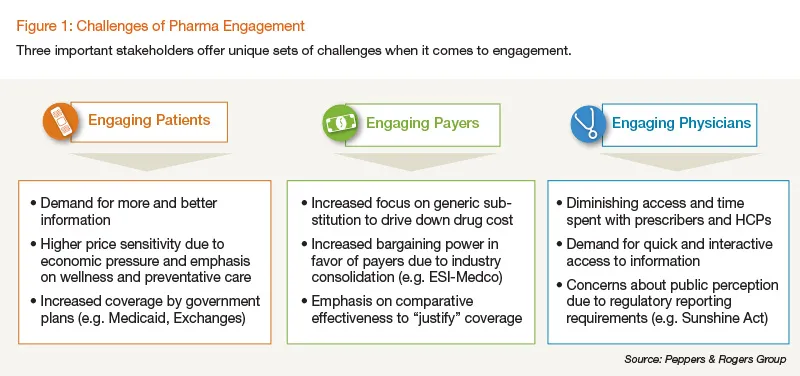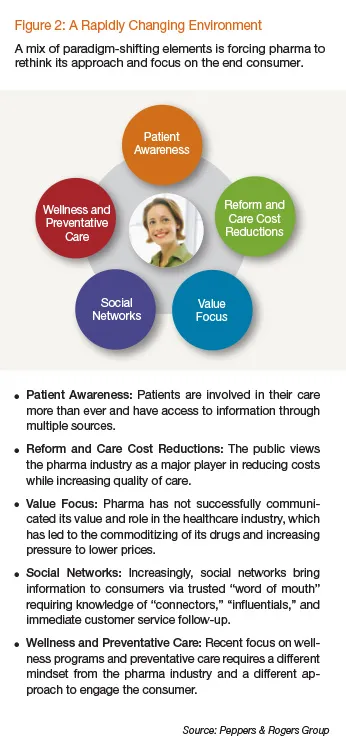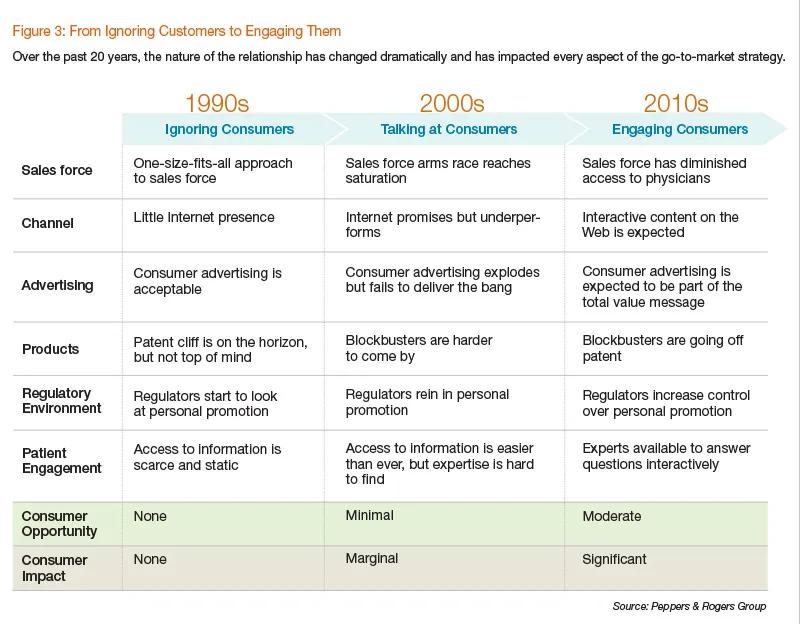The good old days of the blockbusters are gone. The pharmaceutical industry has to adapt to a new reality and the changes that come along with it. The patent cliff is no longer years away, it is here now. Healthcare reform, changing customer expectations, technology advancements, and cost containment signal that pharma companies must rethink the traditional industry paradigm.
The emerging healthcare ecosystem is one where the patient is a focal point for a myriad of healthcare services. In order for pharma to participate in the new ecosystem, the industry must not only focus on the patient, but also partner with its stakeholders to improve health outcomes, costs, and experiences. Organizations will thrive if they transition by recognizing and engaging their respective constituencies. Those that don't will experience the full force of changing market dynamics.
Pharma companies must step back and think strategically, starting with the definition of "customer." The definition of customer has evolved from "someone who buys good or services" to "an individual with whom one must deal," which implies emphasis on the relationship. In pharma, a customer can be a patient, physician, payer, or provider. Companies that proactively engage the customer, whoever that may be, will be able to navigate the rapidly changing environment. The emerging business model is one that accentuates consumer choice, explicit value versus price considerations, engagement and dialog, and lifestyle care.
Pharma companies will have to overcome current challenges when engaging different stakeholders. It's up to them to recognize these components and craft customer-centric strategies that identify, and internally adapt to, change.

Why customer centricity matters in pharma
Pharma must take a new approach to business as the industry transforms. Decision-making was once the domain of the physician, but increased patient activity blurs the line as to who owns the relationship with pharma companies. Balancing cost with effectiveness is a top strategic priority, as is getting the right message to the right constituencies through multiple owned and indepen¬dent channels. And, while engagement is a critical consideration, communication and dialogue with stakeholders is happening outside of traditional venues. Pharma must contend with new audi¬ences looking for new products and new information in new channels, all while managing costs and delivering safety and efficacy. In addition, pharma must focus on delivering value as part of engaging healthcare stakeholders (e.g. payers and providers).
Patients are changing their attitudes and behavior toward healthcare. They have an increased awareness and role in decision-making, due in large part to shifting financial responsibility. They are hungry for information from numerous sources—from their doctor and health insurer to their pharmacist, drug companies, independent experts, and peers. They are looking for guidance as they navigate the increasingly complex world of healthcare. And, they want to break down traditional communication barriers to enable interactive dialogue, not just a one-way flow of information.
The days of controlling the message are over. Transparency is expected, and complete control is a thing of the past. Customer-focused pharma companies seek out opportunities to transparently engage consumers, physicians, payers, and other customer groups wherever discussion is taking place. And, as channels expand, opportunities arise to interact efficiently, effectively, and relevantly with different stakeholder groups in preferred and appropriate channels, depending on the needs, values, and behaviors of each group.
Customer centricity provides pharma companies with a blueprint for engaging all parties by focusing on their needs and priorities, highlighting product value, and delivering quality products and services. As healthcare delivery shifts from consumer awareness to decision management, pharma must analyze and act on data about patients, physicians, payers, and other stakeholders to engage decision-makers at every level. In addition, "total value of treatment" should be driven by the value delivered to the patients and their experience during the treatment process.
Four pillars of pharma customer engagement
Political, economic, social, cultural, technological, legal, and business trends have evolved to create a new paradigm. The industry mindset has changed from ignoring customers to informing and engaging them, with consumer opportunities and impact growing along the way.

The new reality in healthcare means that companies must either take a customer-centric perspec¬tive or succumb to those that do. There are four fronts of customer-centric business strategy where pharma companies can achieve real business results:
- Enhanced Patient Experience: Patients are looking for better information and experiences related to their overall healthcare journey. They are leveraging new tools and channels to create a dialogue about health, disease areas, and drugs. And with economic issues at the forefront, patients are seeking value while being cost-conscious.
- Effective Commercial Model: New marketing tactics are available to transform the commercial model to resonate with Healthcare Professionals (HCPs). There are also new opportunities to engage physicians and healthcare providers in more interactive and efficient ways.
- Improved Payer Engagement: Targeting and messaging to payers can be improved by addressing their pain points while still remaining profitable. Information-sharing and dialogue is critical with this constituency, with emphasis on patient adoption and access to drugs.
- Informed Medical Relationship: It's important to engage the medical community to ask for feedback and gain insight based on their expertise and experience. There are new tools and channels that can be leveraged to share information and research more effectively with the medical community.
Moving to a customer-centric approach can be a competitive advantage and strategic lever as pharma rethinks how to engage different customer constituencies: patients, physicians, payers and providers. In order to successfully transform, pharma must focus on improving the customer experience, which requires a change in paradigm in both customer-facing and internal operations.
Pharma must proactively redefine and, in most cases, establish a relationship with patients to meet the demand for patient-centric service. Patients now expect the same level of service and engagement in healthcare as other services they receive from other industries (e.g. telecom, financial services, or retail). Therefore, pharma should find ways (within the regulatory constraints) to engage patients, leveraging a patient-centric view based on patients' needs and behavior, as well as consumer insights best practices from other industries. For instance, many CPG and retail companies have effectively leveraged customer journey maps and established appropriate interaction channels. Pharma would also need to advance its understanding of the patient journey not only during the treatment, but also prior to and after their diagnosis.
As pharma moves away from the traditional sales force model, it must find innovative, but less intrusive ways to communicate and interact with physicians. There should be more emphasis on the HCP's priorities, needs, and available communication channels. Additionally, pharma must develop trust with Key Opinion Leaders (KOLs) and physicians in order to change the perception of the industry from being sales-focused to a provider of valuable information .

Finally, the pharma industry must transform the historically combative relationship it has had with payers and providers. In the past, those relationships have been focused on formulary and cost. Pharma must forge new relationships that are value-focused, such as reimbursement, formulary decision-making, clinical development guidelines, and patient-oriented services. For example, pharma needs to effectively partner with payers to successfully implement "outcome-based" agreements, which have been slow to be adopted. It's key to understand payers' and providers' pain points and priorities to develop innovative ways to partner with them. Only then will pharma thrive in this engaged new healthcare world.













